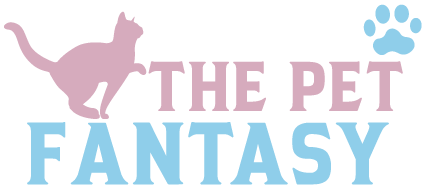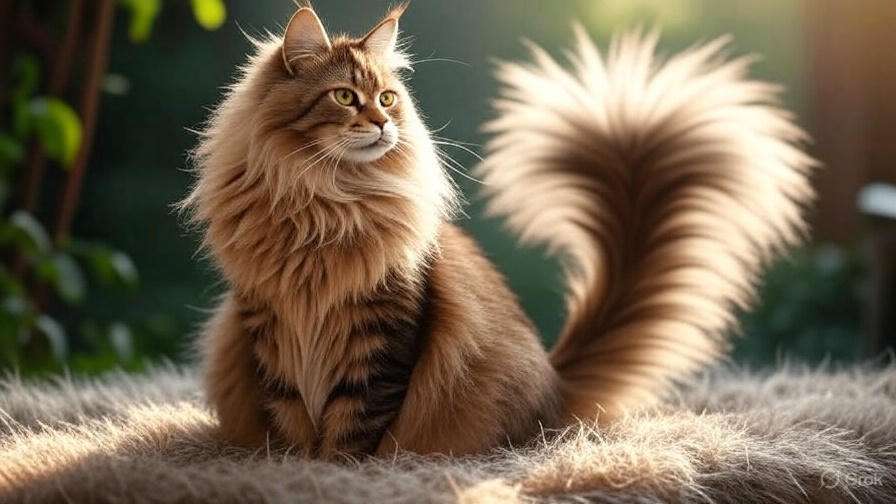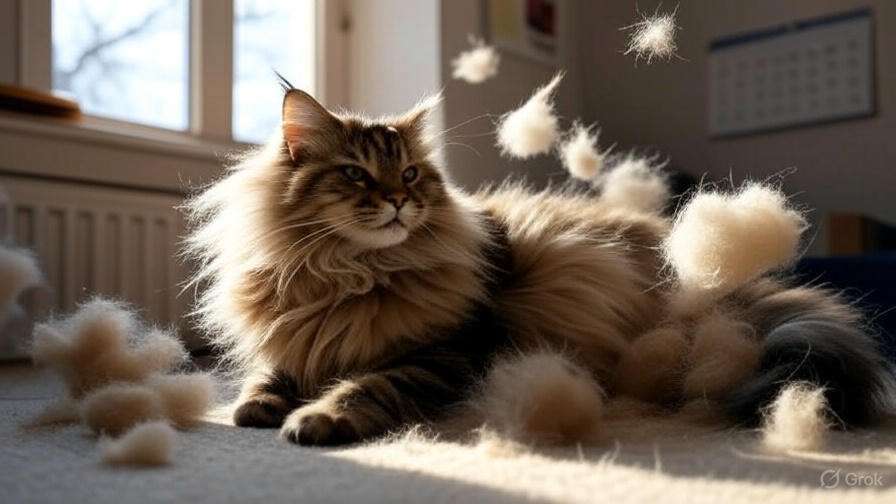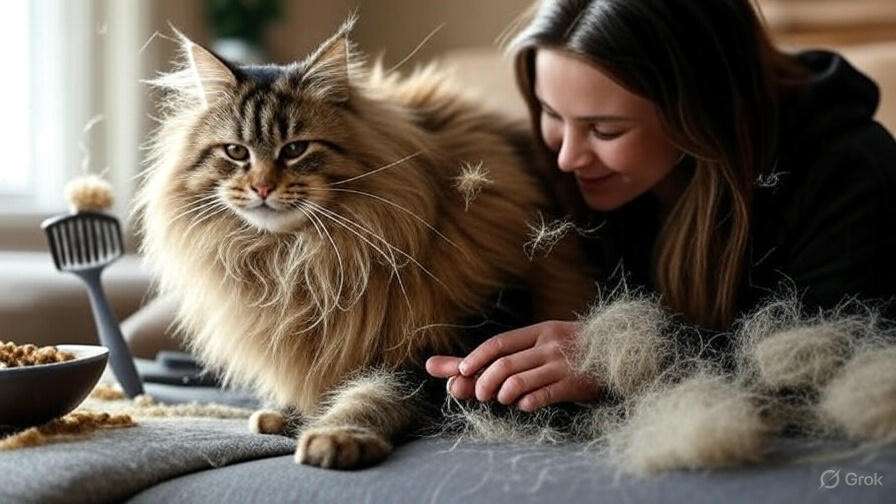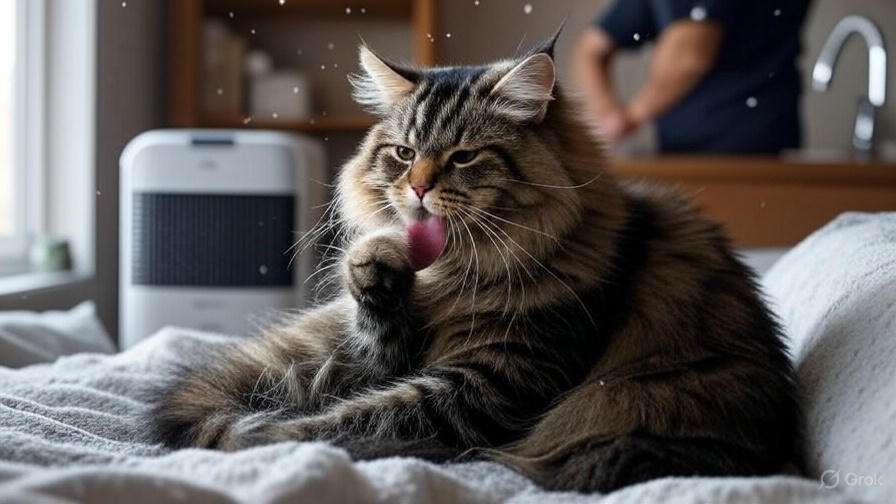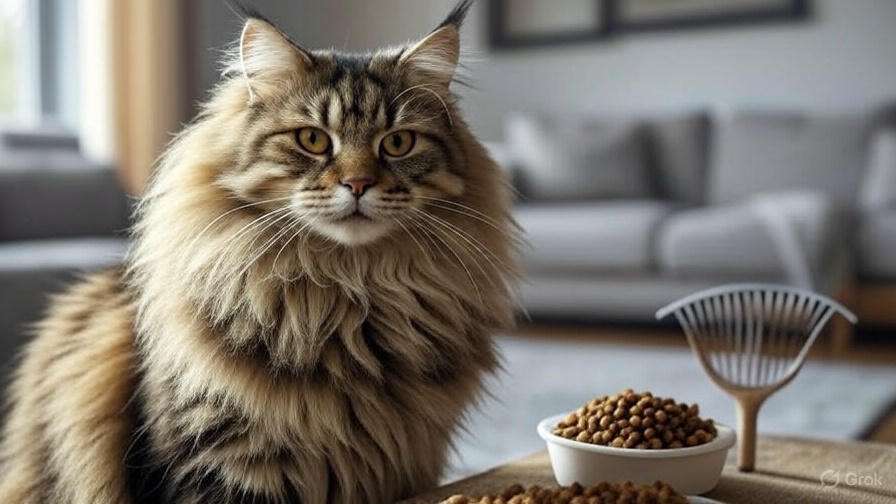
Do Maine Coon Cats Shed? What Every Owner Needs to Know About Managing Their Fur
If you’ve ever found yourself asking, “Do Maine Coon cats shed?”, you’re definitely not alone—and the short answer is yes, they do. But before you picture your home buried in cat hair, there’s good news: Maine Coon shedding is totally manageable—when you know what to expect and how to stay ahead of it.
With their luxurious, lion-like manes and famously fluffy tails, Maine Coons are as majestic as they are affectionate. But that glorious coat comes with a common concern for cat parents: how much do they really shed, and what can you do about it?
In this article, we’ll unpack everything you need to know—from why Maine Coons shed, to when they shed the most, to simple, expert-approved tips for keeping their fur under control (and off your furniture). Whether you’re a first-time owner or just tired of cleaning up tufts of fluff, this guide will give you the answers—and peace of mind—you’re looking for.
Let’s dive into the world of Maine Coon fur care, so you can enjoy all the fluff without the frustration.
Table of Contents
Toggle1. Understanding the Maine Coon Coat 

Before we talk about shedding, it’s important to understand what makes the Maine Coon’s coat so special—and why it behaves the way it does.
 A Double-Layered Masterpiece
A Double-Layered Masterpiece
Maine Coons have a thick, double-layered coat designed to protect them from harsh winters.
- Outer layer (guard hairs): Long, water-resistant hairs that keep them dry
- Undercoat: Soft, dense fur that provides insulation
This unique combo is beautiful—but it also means more fur to shed, especially during seasonal changes.
 Strategic Fur Growth
Strategic Fur Growth
Maine Coon fur doesn’t grow evenly.
You’ll notice longer fur:
- Around the neck (like a mane)
- On the belly and britches
- Along their plumed tail
These areas are also the most prone to tangling and matting, especially if not groomed regularly.
 Kitten to Adult Transition
Kitten to Adult Transition
Maine Coon kittens start with a softer, lighter coat. As they grow (usually over the first 3–5 years), their full adult coat develops—bringing in heavier fur and more noticeable shedding.
 Male vs. Female Coats
Male vs. Female Coats
Males tend to have thicker, fuller coats, which can lead to more visible shedding than females. But regardless of gender, all Maine Coons benefit from regular coat care.

The Maine Coon’s coat is stunning, but it requires attention. Understanding its structure is the first step to managing shedding effectively—and keeping your cat (and your home) looking its best.
2. Shedding Explained 

Now that you understand the Maine Coon’s luxurious coat, let’s talk about what you really came here for: shedding. Yes, Maine Coon cats do shed—and for good reason. But how much they shed, and why, depends on several key factors.
 Seasonal Shedding: The Natural Cycle
Seasonal Shedding: The Natural Cycle
Maine Coons are known for heavy seasonal shedding, especially in:
- Spring – when they shed their thick winter undercoat
- Fall – to prepare for growing a warmer coat again
During these times, you may notice extra clumps of fur, more frequent matting, or even fur floating through the air like tumbleweeds. 
 Indoor vs. Outdoor Cats
Indoor vs. Outdoor Cats
Indoor Maine Coons experience less dramatic seasonal shifts due to artificial lighting and stable temperatures.
This means they may shed small amounts all year, rather than a lot all at once.

 Life Changes = Fur Changes
Life Changes = Fur Changes
Several other factors can trigger extra shedding, including:
- Hormonal shifts (like after spaying or neutering)
- Stress or anxiety (moving, new pets, loud noises)
- Diet changes or illness
- Age – older cats may shed more due to reduced grooming habits


Yes, Maine Coons shed—and sometimes quite a bit. But when you understand why they shed and when to expect it, you’ll be much better prepared to manage the mess and keep your cat comfortable.
3. How to Manage Maine Coon Shedding (Practical Tips) 

If your Maine Coon is leaving a trail of fur behind, don’t worry—you’re not powerless. With the right grooming habits and a few smart tools, you can significantly cut down on shedding and keep your cat (and your home) looking its best. Here’s how to make shedding manageable, not messy.
 1. Brush Regularly (and Correctly)
1. Brush Regularly (and Correctly)
Brushing is your #1 defense against shedding. It removes loose hair before it ends up on your couch or clothes.
- Frequency: Aim for 3–4 times a week. Daily brushing is ideal during spring and fall.
- Best brushes for Maine Coons:
Slicker brush – great for daily grooming
Undercoat rake – helps remove dead fur during shedding season
Wide-tooth comb – perfect for detangling belly and behind-the-ears mats

 2. Bathe Occasionally
2. Bathe Occasionally
Bathing isn’t essential, but it can help loosen dead hair and reduce shedding.
- How often: Every 4–6 weeks (or as needed)
- Use: Cat-safe shampoo formulated for long-haired breeds
- Dry thoroughly: Use a towel followed by a low-heat blow-dryer (if your cat tolerates it)

 3. Feed for a Healthy Coat
3. Feed for a Healthy Coat
A dull, dry coat often means something’s missing in the diet. Shedding can be worsened by poor nutrition.
- Look for high-protein, high-quality cat food
- Add Omega-3 and Omega-6 fatty acids (some foods include these, or ask your vet about supplements)
- Always provide fresh water to support skin hydration

 4. Reduce Stress
4. Reduce Stress
Yes, stress can make your Maine Coon shed more! Sudden changes, loud noises, or boredom may lead to over-grooming or fur loss.
- Keep a consistent routine
- Provide toys, scratchers, and quiet spaces
- Use calming sprays or pheromone diffusers if needed

 5. Don’t Forget the Vet
5. Don’t Forget the Vet
If you notice excessive shedding, bald patches, or red skin, it’s time to see your vet.
Common medical causes include:
- Skin allergies
- Parasites (like fleas or mites)
- Thyroid or hormonal issues
- Nutrient deficiencies

Takeaway:
Maine Coon shedding doesn’t have to take over your life (or your furniture). With the right grooming tools, a solid routine, and good nutrition, you can keep your cat’s coat healthy and your home fur-free—without the stress.
4. Diet, Health & Environment 


Maine Coon shedding isn’t just about grooming—it’s also deeply connected to what your cat eats, how healthy they are, and the environment they live in. If you want to truly reduce excess shedding, these areas matter just as much as brushing.
 Nutrition: Fuel for a Healthy Coat
Nutrition: Fuel for a Healthy Coat
A shiny, low-shed coat starts with the right diet. Poor nutrition can lead to dry skin, brittle fur, and more shedding.
Here’s what to focus on:
- High-protein foods – Maine Coons are large, active cats that need quality animal protein.
- Omega-3 & Omega-6 fatty acids – These support skin hydration and reduce shedding (found in salmon oil, flaxseed, and some premium cat foods).
- Hydration – Always provide fresh, clean water to prevent dry, flaky skin.

 Health: When Shedding Signals a Problem
Health: When Shedding Signals a Problem
Some shedding is normal. But sudden, heavy, or patchy hair loss could point to a health issue. Keep an eye out for:
- Bald spots or irritated skin
- Constant scratching or licking
- Dull, greasy, or brittle fur
- Behavior changes (lethargy, hiding, aggression)
Potential causes include:
- Allergies (food, dust, pollen)
- Parasites like fleas or mites
- Fungal infections (e.g. ringworm)
- Thyroid imbalances or other medical conditions

 Environment: Comfort Impacts Shedding
Environment: Comfort Impacts Shedding
Stress, temperature, and light exposure can also affect how much your Maine Coon sheds.
- Indoor vs. outdoor living – Outdoor cats shed more seasonally; indoor cats shed more steadily throughout the year.
- Temperature and humidity – Dry air can lead to flaky skin; consider a humidifier during winter.
- Stress – Big changes (moving, new pets, loud noises) can trigger excessive grooming or fur loss.


A healthy Maine Coon sheds less—it’s that simple. Feed them well, monitor their health, and create a low-stress environment to support a happy cat and a cleaner home.
5. Controlling Cat Hair in Your Home 


Even with regular grooming, some Maine Coon fur will find its way around your home—especially during shedding season. But don’t stress! With a few simple habits and the right tools, you can keep your space clean and fur under control. Here’s how:
 1. Designate “Cat Zones”
1. Designate “Cat Zones”
Give your Maine Coon a few cozy, fur-friendly spots they love to lounge in.
- Use washable blankets or pet mats on furniture
- Train them to relax on their own bed or tower

 2. Use the Right Cleaning Tools
2. Use the Right Cleaning Tools
Not all vacuums are created equal when it comes to cat hair. Look for:
- Vacuum with a HEPA filter – traps dander and fur
- Rubber brooms or gloves – great for lifting fur off furniture
- Lint rollers and fabric brushes – quick fixes for clothes and cushions

 3. Control Static & Airflow
3. Control Static & Airflow
Dry air = clingy fur. You can reduce airborne hair and static buildup by:
- Using a humidifier in colder months
- Running an air purifier with a pet dander filter
- Opening windows regularly (if safe) for ventilation

 4. Wash Bedding & Blankets Weekly
4. Wash Bedding & Blankets Weekly
Cat fur clings to fabric, especially fleece and wool. Wash your cat’s bedding (and your own) once a week using:
- Warm water
- Unscented, pet-safe detergent
- Optional: Add white vinegar to loosen hair in the wash

 5. Stick to a Routine
5. Stick to a Routine
A little bit of cleaning each day beats a massive deep-clean once a month. Create a simple cleaning checklist, like:
- Quick vacuum every 2–3 days
- Lint roll sofas and throw pillows
- Wipe down baseboards and corners weekly (fur hides there!)

Takeaway:
You don’t have to choose between a fluffy cat and a clean home—you can have both! With smart habits and the right tools, you can keep Maine Coon shedding in check and enjoy life with your furry friend (without finding their hair in your coffee 
6. What About Hypoallergenic Claims? 

You may have heard that Maine Coon cats are “hypoallergenic”—but let’s clear up the confusion. If you or someone in your home has cat allergies, it’s important to understand what this really means before bringing one of these fluffy giants into your life.
 Are Maine Coons Truly Hypoallergenic?
Are Maine Coons Truly Hypoallergenic?
No, Maine Coons are not hypoallergenic.
In fact, no cat breed is completely hypoallergenic. Allergies are usually caused by a protein called Fel d 1, which is found in a cat’s saliva, skin oils, and dander—not just their fur.
When cats groom themselves, this protein gets on their fur and eventually ends up on your furniture, clothes, and in the air. Maine Coons, with their thick coats and love for grooming, can actually spread quite a bit of this allergen.
 Why Do Some People Say They Are?
Why Do Some People Say They Are?
Some allergy sufferers report having milder reactions to Maine Coons. This might be due to:
- Slightly lower levels of Fel d 1 in some individuals
- Slower shedding cycles, which reduce how quickly allergens spread
- Their calm temperament, which may mean less frantic grooming or stress-shedding
That said, results vary greatly. What’s manageable for one person may trigger symptoms in another.
 Tips for Allergy Management
Tips for Allergy Management
If you love Maine Coons but have mild allergies, here’s how to reduce reactions:
- Brush and bathe your cat regularly (or have someone else do it)
- Use HEPA air purifiers and vacuum with filters
- Wash hands and change clothes after cuddling
- Keep bedrooms off-limits to your cat
- Talk to an allergist about treatment options

Takeaway:
Maine Coon cats are not hypoallergenic—but with the right steps, it’s still possible to live comfortably with one if your allergies are mild. Always prioritize your health, and make sure you’re fully informed before bringing one of these lovable giants into your home.
7. Real Owner Insights (Optional Add-On) 

Sometimes, the most helpful advice comes from those who live with Maine Coons every day. Here’s what real owners have to say about managing shedding and keeping their homes (and sanity!) in check.
 “Grooming = Game Changer”
“Grooming = Game Changer”
“I brush my Maine Coon every other day. It’s become part of our bonding time, and it really cuts down on shedding around the house.” – Sarah M., Maine Coon owner for 4 years
Why it works: Regular grooming prevents loose fur from ending up on your floors, furniture, and clothes. It also keeps your cat’s coat tangle-free and healthy. Win-win!
 “Invest in Good Tools”
“Invest in Good Tools”
“A robot vacuum and a pet hair remover brush changed everything. I can’t imagine managing my two Maine Coons without them.” – Liam P., Cat dad to Moose & Mabel
Why it works: The right cleaning tools save time and energy, especially if you’re dealing with multiple cats or heavy shedders.
 “Diet Made a Big Difference”
“Diet Made a Big Difference”
“When we switched to a high-protein, grain-free food with omega-3s, my Maine Coon’s coat got shinier—and the shedding decreased!” – Jasmine K., Maine Coon owner
Why it works: A healthy coat starts from the inside. Nutrient-rich food supports skin and fur health, naturally reducing excess shedding.
 “Don’t Skip Vet Visits”
“Don’t Skip Vet Visits”
“I thought the shedding was normal until the vet found a skin allergy. After treatment, the fur loss slowed way down.” – Carlos D., Maine Coon owner of 6 years
Why it works: Sometimes, what seems like normal shedding is actually a sign of an underlying issue. Regular checkups help you catch problems early.
 Final Thoughts from the Community
Final Thoughts from the Community
While every Maine Coon is different, one thing all owners agree on is this: shed happens—but with consistency and care, it’s absolutely manageable.

Shedding is a natural part of life with a Maine Coon, but it doesn’t have to feel overwhelming. By understanding their unique coat, embracing regular grooming, supporting their health with good nutrition, and managing your home environment, you can keep shedding under control—and enjoy every fluffy moment with your majestic companion.
Remember, patience and consistency are key. With these practical tips and insights, you’re well-equipped to tackle Maine Coon shedding confidently and keep your home clean and comfortable.
Ready to embrace the fluff? Your Maine Coon—and your furniture—will thank you!
Frequently Asked Questions (FAQs)
1. Do Maine Coon cats shed a lot?
Yes, Maine Coon cats shed moderately to heavily, especially during seasonal changes (spring and fall). Their long, thick fur requires regular grooming to manage shedding and prevent matting.
2. When do Maine Coons shed the most?
Maine Coons typically shed more during spring and fall as they transition between their winter and summer coats. However, indoor cats may shed consistently year-round due to stable indoor temperatures and lighting.
3. How can I reduce shedding in my Maine Coon?
You can reduce shedding with regular brushing (2–4 times a week), a healthy, balanced diet rich in omega-3 fatty acids, and routine vet checkups. Clean living spaces and proper hydration also help maintain coat health.
4. What’s the best brush for Maine Coon shedding?
A wide-toothed comb or slicker brush is ideal for Maine Coons. Look for tools that gently remove loose undercoat without tugging or causing discomfort.
5. Are Maine Coon cats hypoallergenic?
No, Maine Coon cats are not hypoallergenic. They produce the Fel d 1 protein, which is the main cause of cat allergies, and their long fur can carry more allergens around the home.
6. Can poor diet cause excessive shedding in Maine Coons?
Yes, an unbalanced or low-quality diet can lead to dry skin and increased shedding. Feeding your Maine Coon high-quality food with proper nutrients supports healthy skin and fur.
7. How do I keep my home clean with a shedding Maine Coon?
Use HEPA-filter vacuums, lint rollers, washable covers on furniture, and air purifiers. Daily or weekly cleaning routines can make a big difference in managing fur around your home.
8. Is excessive shedding ever a sign of a health problem?
Yes, sudden or severe shedding can be a sign of allergies, stress, skin conditions, or other health issues. If your cat’s shedding seems abnormal, consult your veterinarian for a check-up.
